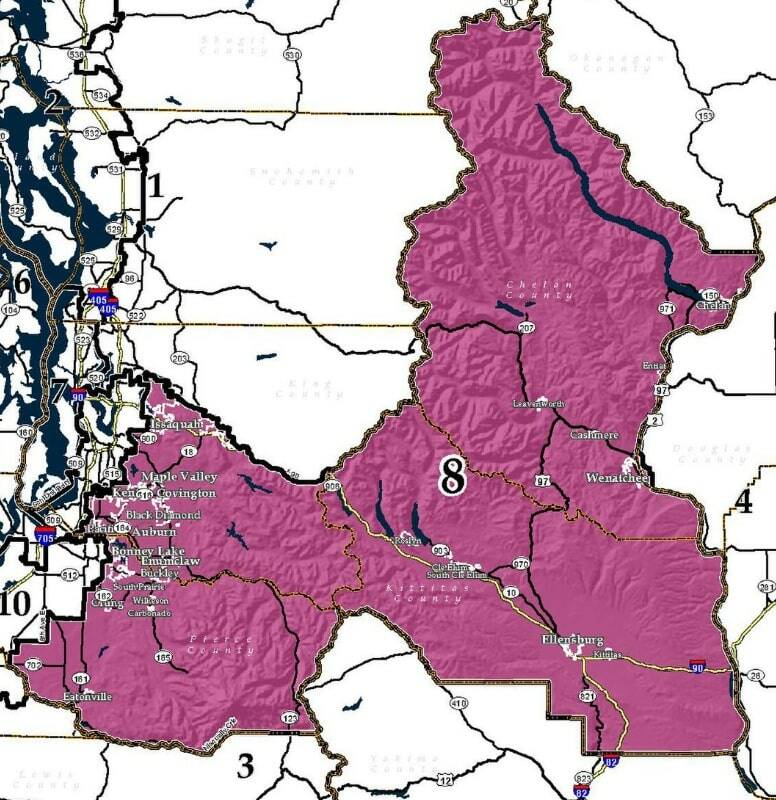The four voting members of the Washington Redistricting Commission each released a proposed map Sept. 28 for the redrawing of the state’s congressional districts, which could swing the competitive 8th District.
Every decade, the congressional districts are redrawn following the census to create districts that better reflect how the population has changed. The goal is to create districts that represent similar communities and groups while keeping each district roughly the same size and not giving any political party an unfair advantage.
“Now that draft maps are available, we are looking forward to our public outreach meetings,” said Sarah Augustine, the commission’s chair.
The public will have the opportunity to comment on the proposed congressional maps at a virtual meeting held by the commission on Oct. 9. Residents can also comment anytime online.
The Snoqualmie Valley is currently split among the 8th and 1st Congressional Districts, with the Snoqualmie River serving as somewhat of a boundary line for those in Fall City, North Bend and Snoqualmie. Those on the west side of the Snoqualmie River in these three cities are generally in the 8th District and those on the east side are in the 1st District.
The commission, which is split among two Democrats and two Republicans, is aiming for each of the state’s 10 districts to have a roughly equal population of 771,595 people. The 8th District currently has a population of 770,117.
All four of the proposed maps would keep the majority of the Snoqualmie Valley in the 8th Congressional District, near the district’s boundary — and two of the proposed maps would move Carnation into the same district.
The biggest change between the maps for Valley residents is determining who else votes in their district. Since the district’s beginning, it has been mostly represented by Republicans — the most recent being Dave Reichert (R-Auburn), who first won the seat in 2004. In 2012, 2014, and 2016, he won reelection by nearly 20% of the vote.
Recently, the district has shifted to lean Democratic. Current Rep. Kim Schrier (D-Sammamish) became the first Democrat to win the seat when she won by 5% of the vote in 2016. She won the seat again in 2020, this time by 3.6%.
The 8th District covers much of the central portion of the state, including the Snoqualmie Valley, Issaquah, Ellensburg, Leavenworth and Chelan. It includes parts of King, Pierce, Kittitas and Chelan counties.
The two Democrats on the commission proposed small changes to the 8th Congressional District. April Sims, the secretary treasurer of the Washington State Labor Council, proposed adding the remainder of the northeastern part of King County, including Carnation and Skykomish, into the district.
The other Democrat on the commission, Brady Pinero Walkinshaw, a former state legislator and the current CEO of Grist Magazine, proposed to continue to divide the 8th District down the Snoqualmie River, but push part of the distric north of Leavenworth into Skagit County.
The Republican members of the commission — Paul Graves, a former state representative, and Joe Fain, the Bellevue Chamber of Commerce president and former state senator — made larger changes to the district, both of which moved Schrier’s hometown outside of the 8th District.
Graves is proposing to shift the district south, making the Snoqualmie Valley its most northern point. The district would include parts of King and Thurston counties and the majority of Pierce County, excluding Tacoma.
Fain proposed the biggest 8th District, which would stretch from central Pierce County to the Canadian border. The district would include all of Chelan and Kittitas County. It would also include part of Pierce County and the majority of Whatcom, Skagit, Snohomish and King County.
Similarly to the legislative maps, both the Democratic and Republican party chairs criticized the other party’s maps.
Washington Republican Party Chairman Caleb Heimlich called the Democrat proposed maps “the least competitive maps in Washington state history.” He went on to add that the state has one of the most bipartisan redistricting systems in the country and accused Democrats of gerrymandering.
Tina Podlodowski, the chair of the state Democratic Party, accused Republicans of gerrymandering, calling it a “desperate — and easy to see — attempt to gain power.” She criticized Fain for splitting the majority of Western Washington counties in half. She also criticized Graves for failing to draw a majority Latino district near Yakima County, a region with three counties that have Latino majority populations.
The four members will have until midnight Nov. 15 to submit two finalized maps to the Washington Legislature. In order for the maps to be sent, three of the four members must agree on them.
To view the four maps or leave a comment, visit www.redistricting.wa.gov/proposed-congressional-maps.


